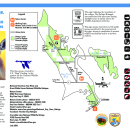Seven of the eight listed species at Crocodile Lake National Wildlife Refuge are dependent on the hardwood hammock forest: Key Largo woodrat, Key Largo cotton mouse, Stock Island tree snail, Schaus’ swallowtail butterfly, Eastern indigo snake, Keys tree cactus, and the Florida semaphore cactus. To compensate for the loss of habitat over the years, the USFWS has put considerable effort into restoring tropical hardwood hammocks by removing and treating invasive exotic plants and planting native trees and shrubs. The final listed species, the American crocodile and namesake of the refuge, lives and nests in the saltwater mangrove habitat.
Visit Us
National wildlife refuges offer us all a chance to unplug from the stresses of daily life and reconnect with our natural surroundings
The lands and waters of Crocodile Lake NWR are closed to general visitation by the public; however, there are many ways you can still enjoy this refuge.
- The refuge has a small visitor area that includes a native butterfly garden, an informational kiosk, and a visitor center that is staffed seasonally by volunteers.
- Special events are hosted each year, primarily during the winter months. These bird, botanical, and nature walks, as well as historical tours, give you a behind-the-scenes look at this amazing national wildlife refuge national wildlife refuge
A national wildlife refuge is typically a contiguous area of land and water managed by the U.S. Fish and Wildlife Service for the conservation and, where appropriate, restoration of fish, wildlife and plant resources and their habitats for the benefit of present and future generations of Americans.
Learn more about national wildlife refuge . - Volunteering is another way to access the refuge. Trash cleanups, tree planting projects, python patrols, wildlife surveys, and restoration of the butterfly garden are all ways volunteers can be part of the Crocodile Lake team.
Location and Contact Information
What We Do
Refuges deploy a host of scientifically sound management tools to address biological challenges. These tools span active water management to wilderness character monitoring, all aimed at ensuring a balanced conservation approach to benefit both wildlife and people. At this field station our conservation tool box includes:
Habitat Restoration and Management-
To compensate for the loss of habitat over the years, the USFWS as well as other organizations have put a considerable amount of effort into restoring tropical hardwood hammocks by removing and treating invasive exotic plants and planting native trees and shrubs.
Wildlife Management-
Ongoing research documents the status and trends of threatened, endangered, and imperiled species populations. As part of the monitoring strategy, the refuge documents changes in species composition over time in response to management actions, as well as to natural disturbances (e.g. hurricanes, flooding), and climate change climate change
Climate change includes both global warming driven by human-induced emissions of greenhouse gases and the resulting large-scale shifts in weather patterns. Though there have been previous periods of climatic change, since the mid-20th century humans have had an unprecedented impact on Earth's climate system and caused change on a global scale.
Learn more about climate change .
Pest Management-
Removal of exotic wildlife species (Burmese pythons and other reptiles) and feral and domestic pets that threaten the survival of native species is ongoing on the refuge.
Education and Outreach -
Education and outreach through our visitor services program is one of the most powerful management tools our refuges have for meeting our mission. Working with visitors and the local community, we explain why Crocodile Lake NWR is important for people and wildlife and to highlight how people can help make a difference.
Law Enforcement -
Refuge law enforcement is a key management tool to make sure that refuge rules and regulations are followed.
Projects and Research
Python Research and Management
Burmese pythons are an invasive species invasive species
An invasive species is any plant or animal that has spread or been introduced into a new area where they are, or could, cause harm to the environment, economy, or human, animal, or plant health. Their unwelcome presence can destroy ecosystems and cost millions of dollars.
Learn more about invasive species that impact threatened and endangered species at Crocodile Lake NWR. Refuge staff, volunteers, and researchers help with python research and management. Volunteers with the Key Largo Python Patrol routinely survey and remove pythons. The Scout Python project is a partnership with USGS to implant pythons with transmitters to determine range, habitat, and, ultimately, to find and remove other pythons during the breeding season. A python detection dog surveys the refuge and surrounding lands to help find and remove pythons.
Key Largo Woodrat Management
Key Largo woodrats are a medium-sized endangered rodent that’s only found on conservation land in North Key Largo. These rodents build substantial nests from sticks. Much effort has gone into creating starter nests that help bolster woodrat (and the Key Largo cotton mouse) populations. A network of 642 nests, with remote cameras, monitor population trends. Woodrats are impacted by feral cats and Burmese pythons, invasive species that are removed from the habitat. Studies are underway to understand the effects of the invasive black rat on the population dynamics of woodrats.
American Crocodile Management
Efforts are focused on monitoring nests of the threatened American Crocodile population. Hatchling crocodiles are captured, marked, and released to help track population size. Additionally, crocodile nesting areas are supplemented with sand to combat sea level rise and coastal erosion.
Schaus’ Swallowtail Butterfly Management
The Schaus’ Swallowtail butterfly occurs in only a small portion of the upper keys, including the refuge. Volunteers undertake butterfly surveys from April through June each year. The refuge has planted hundreds of torchwood and wild lime plants -- host plants for this beautiful insect.
Restoring Native Habitat
To compensate for the loss of habitat, the USFWS and other organizations have put much effort into restoring tropical hardwood hammocks by removing and treating invasive exotic plants and by planting native trees and shrubs.

